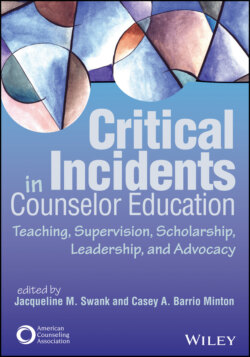Читать книгу Critical Incidents in Counselor Education - Группа авторов - Страница 61
Actions and Outcomes
ОглавлениеPrior to the next class meeting, Professor Dixit decided to use a teaching strategy known as the 3-2-1 assignment (Rutherford, 2002) designed to help students form independent, critical thoughts about material and share their learnings with others (Alsamadani, 2011). Professor Dixit sent out an announcement to all students and emphasized the importance of mindfulness and intentionality when reading the assigned chapters. He explained that after they had read the chapters, he wanted them to (a) identify three words that captured the essence of the chapter, (b) develop two questions around challenging aspects of the reading, and (c) summarize one concept from the readings that had been experienced in a meaningful way during the counseling group.
When the class met the following week, Professor Dixit intentionally formed eight breakout groups of two or three students each so no breakout group consisted of members from a single counseling group. These breakout groups would serve to build a communal experience within the classroom. He asked the students in the breakout groups to share their reflections from the 3-2-1 assignment and any other thoughts associated with readings focused on the stages of the group process. Carla shared that her one meaningful takeaway was how she was afraid of the storming stage. There were things she wanted to express to her group, but she did not feel comfortable doing so. The other two students in Carla’s breakout group expressed similar thoughts and feelings.
Before making an announcement to end the breakout groups, Professor Dixit instructed students to “jot down one or two important or meaningful points from this breakout session.” He invited the students to rejoin as a whole class for that day’s lecture. As a supplement to the stages of group, Professor Dixit discussed Johari’s window (Luft, 1961) and connected the stages of group with how likely a group member was to expose content that was contained in each quadrant of Johari’s window. “For example,” Professor Dixit explained, “during the forming stage, it is more likely that group members will expose aspects of themselves that are held in the arena quadrant, the area that is open to yourself and others. But folks are not as likely to share aspects of themselves that are contained in the façade quadrant, as the group members have yet to develop the norm of pushing one another to be authentic. Authenticity typically arises when the group creates an environment of true trust, and this happens as a result of the storming stage.”
Professor Dixit went on to discuss Johari’s window in more detail and then returned students to their breakout groups. He encouraged them to discuss how the points they had identified in their initial breakout session fit within Johari’s window and group stages. He also challenged them to consider implications of their new learning for their development as professional counselors (i.e., an intersectionality of their identity development).
When she rejoined her breakout group, Carla shared that she was hesitant to disclose aspects of herself that were contained in the façade section of Johari’s window (aspects known to self but not known to others); however, she recognized that she was able to share in the breakout group because students in the group were connected around the idea of not feeling “totally safe.” Carla also made the connection that to be OK with the storming stage as a facilitator, she needed to be OK with going into the storming stage as a group member.
In her next counseling group reflection, Carla described her experience of sharing the effect Johari’s window had on her understanding of self. Although she was nervous, Thomas, the group facilitator, helped her “to make links with various group members.” She also described how her courage in talking about age differences created “external and internal conflict within the group, but the conflict led to deeper and honest conversations.” She concluded her reflection by noting that group dynamics “are now shifting toward the transition stage of group development” and that she was “more open to trusting the group process . . . even if the journey is challenging.”
